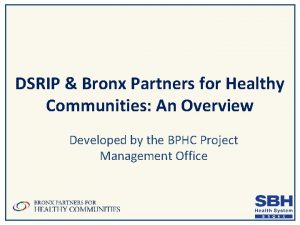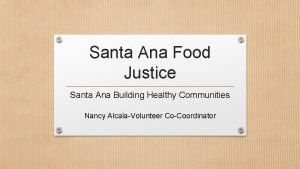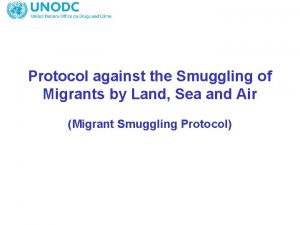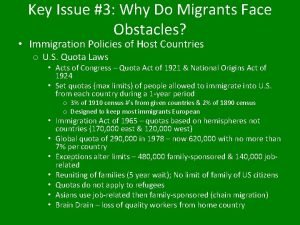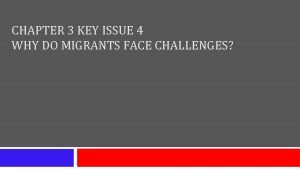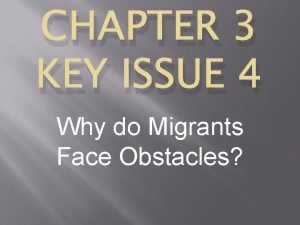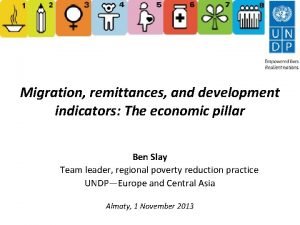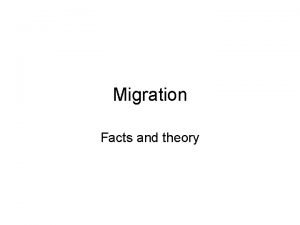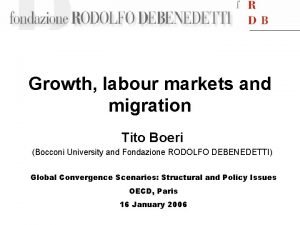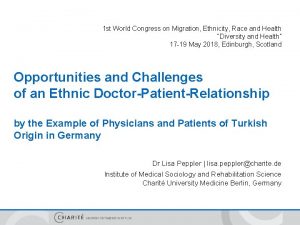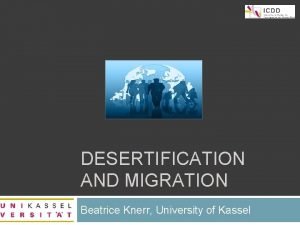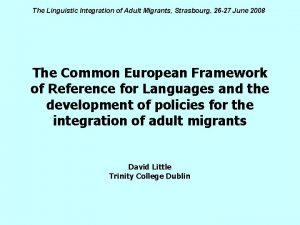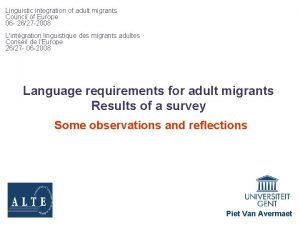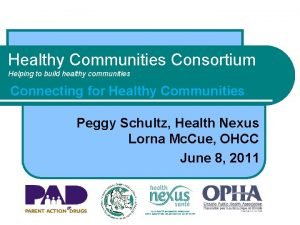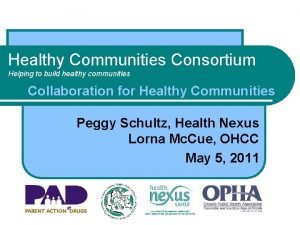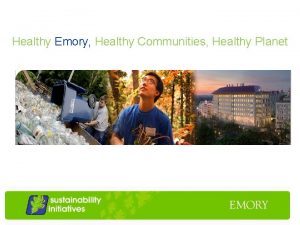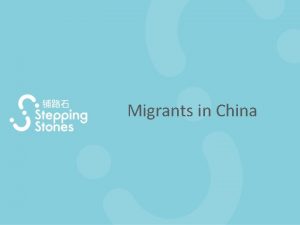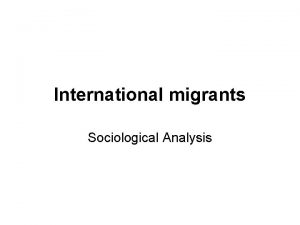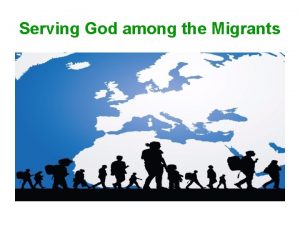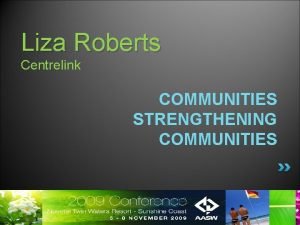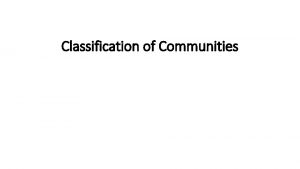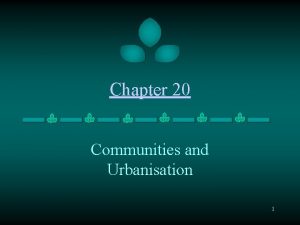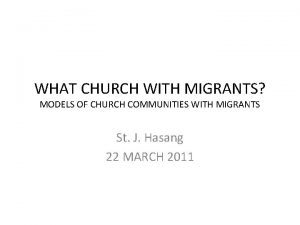Healthy migrants in Healthy communities Dr Carlos Van

















- Slides: 17

Healthy migrants in Healthy communities Dr. Carlos Van der Laat International Organization for Migration Health Division – Regional Office San José

Mensaje Clave: • Although migration is La migración como determinante social de la salud not a risk to health, it is a determinant of health. • Depending on how mobility occurs, the risks of it affecting health increase.

Social Determinants of Health MIG RM N AC ig. Ir ati O on


Spaces of vulnerability according to the stage in the Migration cycle Community of origin Transit Return Destination community

IOM Proposal Guatemala - El Salvador – Honduras - Nicaragua Document Approval Collection of information Investigation Protocol. Technical Committees National Consultations National Dialogues National Plan for Migration and Health Regional Dialogue (OCAM - RESSCAD- COMISCA-CRM) Other Forums Irregular Migrant Population Families fragmented by migration Return population

Vulnerability to the use of drugs q It was found that 16%-36% of participants reported the consumption of alcoholic beverages, and at least 17% increased their consumption at the event of migration q 10% reported the use of drugs, marijuana being the mostfrequentlyconsumed. In the returned population, more than 50% reported an increase in the use of drugs associated with the event of migration. Source: IOM/Sierra

Vulnerability to mental health q It was observed that migration had a greater impact on the mental health of members of fragmentedfamilies and on women. Source: IOM/Sierra

Families fragmented by migration Social-Epidemiological Profile q 1/3 reported at least one member of the family being unwell before the event of migration. q 50% indication that health conditions worsened subsequent to their migration, associating sadness, frustration and anxiety as causes. q 30% indicated improvement, due to receiving remittances to attend to their health conditions Source: IOM/ Sierra

“Since he left I live in anguish, it makes me very nervous, I think that something might happen to him/(…) it has upset my blood pressure, I had to admit myself, then I stabilized/ I think about him a lot, I don’t know where he is (…) and that is affecting my health/ I cry a lot, I have become violent with the children, sometimes I don’t want to eat, I get sick with the flu, the child misbehaves in class and is very rebellious…” (Woman, mother of a migrant. Focus group-Chinandega) Source: IOM/ Jesuit Service-Nicaragua

Premise of Health and Migration (Human Rights Focus) Pro-active measures to support migrant persons. . NEVER with solely restrictive purposes

Monitoring Migration Health Important cause of vulnerability: invisibility Inter-sectoral systems of information • Inclusion of the migration variable To improve the knowledge of trends and results through the breakdown and analysis of the information, considering diversity To compare data and establish links in order to facilitate decision-making and the monitoring of policies and programs Monitoring of behaviors, perceptions, specific needs To follow-up with people who have a high-risk.

Human Resources Training • Migratory and Consular Officials • Basic ability to detect signs and symptoms of infectious/contagious diseases • To develop capacities for intercultural conduct and communication skills • At least 1 or 2 people trained in basic first aid • Information and sensitization about the health of migratory persons (To avoid stigma)

Migrant sensitive systems • Strengthen capacities for response • Kidnapping/trafficking/ rape • Standard Operational Procedures • Training • Also monitor occupational health within the network • Intercultural contextualization Partnerships, multi country framework • Service Network: Bi-national / Regional • Partnerships with Ministries of Health • Communication SOPs

Health in detention centers: Minimum level • Gender: Separation of spaces • Well-lit spaces/ Areas with privacy • Sanitation: provision of basic supplies • Interculturally appropriate • Language • Spaces for prayer • Promotion of mental health • Voluntary access to health services • Health promotion and education

Formal Requests to GRCM • We support Canada’s initiative • To consider the technical support that IOM could contribute with regards to the subject of the health of migrant persons

Healthy Migrants in Healthy Communities Dr. Carlos Van der Laat Migration Health Officer International Organization for Migration cvanderlaat@iom. int
 Healthy forests healthy communities poster contest
Healthy forests healthy communities poster contest Progressive succession examples
Progressive succession examples Bronx partners for healthy communities
Bronx partners for healthy communities Healthy food santa ana
Healthy food santa ana Protocol against the smuggling of migrants
Protocol against the smuggling of migrants Why do migrants face obstacles?
Why do migrants face obstacles? Chapter 3 key issue 4
Chapter 3 key issue 4 Key issue 4 why do migrants face obstacles
Key issue 4 why do migrants face obstacles Migrants
Migrants Migrants
Migrants Rapoport
Rapoport Migrants
Migrants Diseases
Diseases Migrants
Migrants Migrants
Migrants Linguistic integration of adult migrants
Linguistic integration of adult migrants Linguistic integration of adult migrants
Linguistic integration of adult migrants Healthy food healthy mind journal
Healthy food healthy mind journal


